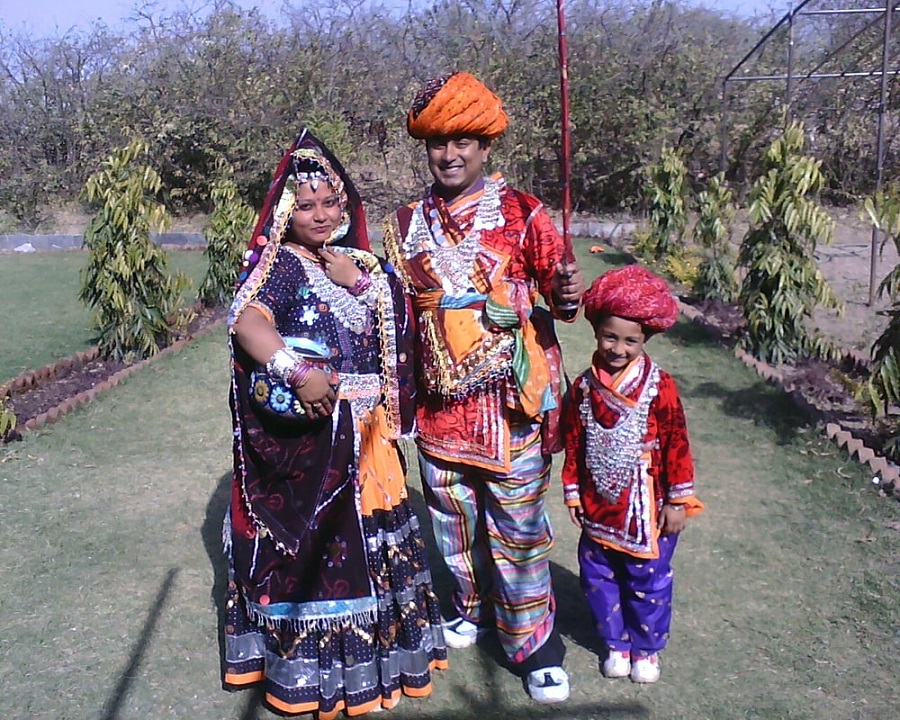The world-famous traditional attire of Rajasthan includes vibrant and intricately designed ghagras (long skirts) for women, paired with odhnis (scarves), and turbans or pagris for men, reflecting the state’s rich cultural heritage and royal history.
The Vibrant Colors of Rajasthan’s Traditional Attire
Rajasthan, the land of kings, is renowned for its vibrant culture and rich heritage. The traditional attire of this region is a true reflection of its colourful and diverse culture. Every garment tells a story, not just of the individual wearing it, but of the community, the land, and the history. The blend of bright colours, intricate designs, and exquisite fabrics make Rajasthani traditional attire one of the most breath-taking in India.
The Majestic Ghagra and Choli – Famous Traditional Attire of Rajasthan
For women, the Ghagra and Choli stand out as iconic pieces of traditional Rajasthani attire. The Ghagra is a long, flared skirt that comes in a plethora of colors and designs. Made from fabrics such as cotton, silk, and georgette, these skirts are often adorned with intricate embroidery, mirror work, and beautiful patterns. The Choli, a fitted blouse worn with the Ghagra, complements the look with its detailed craftsmanship. Together, they create a stunning ensemble that is both elegant and vibrant.
The Graceful Odhni – One of the top Traditional Attire of Rajasthan
An essential part of a Rajasthani woman’s attire is the Odhni or Dupatta. This long scarf is draped gracefully over the head and shoulders, adding an extra layer of elegance to the Ghagra and Choli. The Odhni is often embellished with gota patti work, sequins, and colorful embroidery, making it a significant accessory in the overall attire. It serves not just as an ornament but also as a symbol of modesty and tradition.
Suggested Tour Packages:-
- Royal Rajasthan Tour Package
- Golden Triangle Tour with Udaipur
- Golden Triangle Tour with Ranthambore
- Golden Triangle Tour with Udaipur and Varanasi
The Royal Bandhani – Another top Most Traditional Attire of Rajasthan
Bandhani, a traditional tie-dye technique, is a hallmark of Rajasthani textiles. This art form, which involves tying small portions of fabric and dyeing them in vibrant colors, creates unique patterns that are both intricate and stunning. Bandhani fabrics are used in a variety of garments, from sarees and turbans to dupattas and lehengas. The vibrant dots and swirls of Bandhani not only add to the visual appeal of the attire but also signify the cultural richness of Rajasthan.
The Regal Pagri :-
Men in Rajasthan traditionally wear the Pagri or turban, which is a significant part of their attire. The Pagri comes in various styles, colours, and patterns, each representing a different community, occasion, or region. These turbans are often made from cotton or silk and are sometimes adorned with zari or gota patti work. Wearing a Pagri is a matter of pride and honor, symbolizing the valor and dignity of Rajasthani men.
The Elegant Angrakha :-
Another quintessential piece of Rajasthani men’s attire is the Angrakha, a traditional upper garment that resembles a frock. Made from cotton or silk, the Angrakha is comfortable yet elegant, often featuring intricate embroidery or block prints. It is typically worn with a dhoti or churidar, completing the traditional look. The Angrakha’s unique design and embellishments make it a standout garment in Rajasthani attire.
The Exquisite Jewelry :-
No traditional Rajasthani attire is complete without its signature jewelry. Women adorn themselves with a variety of ornaments, including Kundan, Meenakari, and Thewa jewelry, which are known for their intricate designs and craftsmanship. From heavy necklaces and earrings to bangles and anklets, the jewelry adds a royal touch to the attire. Men, too, wear jewelry, such as brooches and rings, which complement their regal look.
The Cultural Significance :-
The traditional attire of Rajasthan is more than just clothing; it is a manifestation of the region’s cultural identity and heritage. Each piece of garment, each color, and each pattern carries a deep cultural significance, often linked to social status, community, or festival. The attire not only enhances the aesthetic appeal but also fosters a sense of pride and connection to the Rajasthani roots. The breathtaking traditional attire of Rajasthan is a testament to the rich cultural tapestry and the artistic excellence of its people.






